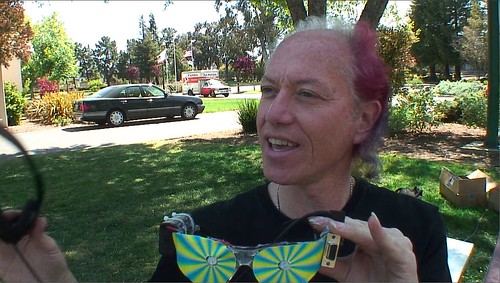Word coming in through the Twitterverse is that there’s a new effort to build a hacker space in Clearwater, FL.
Build a Brain Machine with Mitch at HacDC!
Mitch Altman, microcontroller hacker extraordinaire and inventor of wonderful gadgets like the TV-B-Gone will be at HacDC on Sunday, September 7 at 2:00 PM to help show you how to build your own Brain Machine. Mitch will be bringing all the parts, tools and inspiration necessary, all you need to do is show up!
The event is free and open to the public, however, if you want to build your own Brain Machine, bring $25 to cover the cost of the kit. (HacDC will be purchasing some kits you can help build if you don’t want to take one home.)
Microcontroller Mondays Goes Educational!
What: A five-part microcontroller course, taking you from zero to hero in just 30 days!
Where: The space.
When: Monday nights, 7:00pm to 9:00pm (nominally). Sept 8 through Oct 6.
Syllabus:
Each class will be about 30 min introductory lecture, 20 min lab, 20 min lecture, 20 min lab. We’ll cover two big topics per night (usually) and get cool projects working for each.
0) Setup: What the AVRs are, what all the pins do, what it can do for you. Then the toolchain: soldering together the programmer kits, getting the software up and running. Reading the datasheets. Labs: building the kit and running a test LED flasher. (Almost all lab today, little talk.)
1) Outputs and bit math: How to make chips speak to the outside world, pin-by-pin. Enough C programming fundamentals to make it work. Pulse-width modulation. Labs: Cylon eyes and dimming LED’s. Extra credit: cross-fading cylon eyes!
2) Inputs: Buttons and Analog-to-Digital conversion (ADC). Gather data input the world. Labs: pushbutton organ, light-dependent theremin. Extra credit: something else!
3) Interrupts and Timers: Interrupts call subroutines when certain conditions are true. Timers let you time stuff. Together, they take a lot of the programming burden off your shoulders, and enable really cool stuff. Labs: Driving servo motors and/or build a better audio synth, use an LED as a light-source and light-sensor. Extra credit: capacitive touch-switch!
4) Serial I/O: Make the micro speak to your computer (and vice-versa). We can also cover other serial protocols (I2C, SPI). Labs: Basic serial in/out, data-logging light sensor. Maybe SD/MMC cards? Extra credit: ADC + serial output + Python + laptop = ghetto oscilloscope.
5) EEPROM, PROGMEM, etc: Tying up loose ends, special requests. PROGMEM lets you use the program memory to store lots of (constant) data. EEPROM is like flash — there’s not much of it, but it stays when you power off. Can also do misc topic requests here. Labs: writing out really long strings to serial, saving last known states for battery failure. Maybe I can think up something sexy to use these methods. Maybe not.
The Kit: The class will be based around the ATMega 48 ($4 in bulk). The basics of a programming kit for the AVR chips include: a computer (bring a laptop), a programmer ($22), a breadboard ($5). We’ll be rounding out the projects with some push-buttons, LEDs, light-sensing resistors, speakers, and servo motors. Some of this stuff is in the space, some I’ll bring in, and some will be bought for you all. $35 for the basic kit, delivered.
For $20 more, you can opt to get a super-swanky USB/TTL-serial cable, which will enable simple and clean bi-directional communication with laptops. I highly recommend ponying up for one if you think you’ll continue using micros, but if you want to kludge something together out of a plain-old USB/RS-232 Serial converter, I can help.
Let me know by Friday, Aug 29, what kind of kit you want and if you’re interested but bringing your own gear.
HacDC Training: Introduction to Python
WHERE: HacDC 1525 Newton ST NW Washington D.C. 20010
WHEN: Saturday August 30, 2008 from 1:00PM – 4:00PM
WHO: Rob Seger
So you’ve got this great new idea, but it requires a computer.. The
blasted thing just doesn’t do what you need it to do out of the box.
You’ve got a few options: you can give up on your project (I’m just
saying..), you can find a programmer to whisper sweet nothings to your
expensive doorstop (you may have to bribe them), or you can master the
art of pillow talk for your processor. Presumably, you’re interested
in the last option. While I can’t promise you that you’ll become the
Fabio of circuitry over-night, I can promise you’ll know how to
motivate that doorstop of yours if you attend my class.
In a less-than-formal environment, I plan to take you from not even
having python installed to understanding the fundamentals of
programming. If all goes well, you should be able to create fairly
complicated programs, understand (and know how to find) the python
online documentation, and have this irrational urge to learn more. For
those with some background in programming, we’ll be covering:
variables, if-statements, looping, fundamental data structures,
functions, and modules. If that didn’t make any sense, or you don’t
already know how to do all that in python, this is the class for you!


